�
A.R. Jha/MEMS and Nanotechnology-Based Sensors and Devices AU8069_C000 Final Proof page i 8.3.2008 6:13pm Compositor Name: BMani
MEMS and
Nanotechnology-Based
Sensors and Devices
for Communications,
Medical and
Aerospace
Applications
A.R. Jha, Ph.D.
A.R. Jha/MEMS and Nanotechnology-Based Sensors and Devices AU8069_C000 Final Proof page ii 8.3.2008 6:13pm Compositor Name: BMani
CRC Press
Taylor & Francis Group
6000 Broken Sound Parkway NW, Suite 300
Boca Raton, FL 33487-2742
© 2008 by Taylor & Francis Group, LLC
CRC Press is an imprint of Taylor & Francis Group, an Informa business
No claim to original U.S. Government works
Printed in the United States of America on acid-free paper
10 9 8 7 6 5 4 3 2 1
International Standard Book Number-13: 978-0-8493-8069-3 (Hardcover)
This book contains information obtained from authentic and highly regarded sources Reasonable efforts
have been made to publish reliable data and information, but the author and publisher cannot assume
responsibility for the validity of all materials or the consequences of their use. The Authors and Publishers
have attempted to trace the copyright holders of all material reproduced in this publication and apologize
to copyright holders if permission to publish in this form has not been obtained. If any copyright material
has not been acknowledged please write and let us know so we may rectify in any future reprint
Except as permitted under U.S. Copyright Law, no part of this book may be reprinted, reproduced, trans-
mitted, or utilized in any form by any electronic, mechanical, or other means, now known or hereafter
invented, including photocopying, microfilming, and recording, or in any information storage or retrieval
system, without written permission from the publishers.
For permission to photocopy or use material electronically from this work, please access www.copyright.
com (http://www.copyright.com/) or contact the Copyright Clearance Center, Inc. (CCC) 222 Rosewood
Drive, Danvers, MA 01923, 978-750-8400. CCC is a not-for-profit organization that provides licenses and
registration for a variety of users. For organizations that have been granted a photocopy license by the
CCC, a separate system of payment has been arranged.
Trademark Notice: Product or corporate names may be trademarks or registered trademarks, and are
used only for identification and explanation without intent to infringe.
Library of Congress Cataloging-in-Publication Data
Jha, A. R.
p. cm.
MEMS and nanotechnology-based sensors and devices for communications,
medical and aerospace applications / A.R. Jha.
“An Auerbach title.”
Includes bibliographical references and index.
ISBN-13: 978-0-8493-8069-3 (alk. paper)
ISBN-10: 0-8493-8069-3 (alk. paper)
1. Microelectromechanical systems. 2. Detectors. 3.
Telecommunication--Equipment and supplies. 4. Medical instruments and apparatus.
5. Aerospace engineering--Equipment and supplies. 6. Aeronautics--Equipment and
supplies. I. Title.
TK7875.J485 2008
620’.5--dc22
Visit the Taylor & Francis Web site at
http://www.taylorandfrancis.com
and the CRC Press Web site at
http://www.crcpress.com
2007040799
�
A.R. Jha/MEMS and Nanotechnology-Based Sensors and Devices AU8069_C000 Final Proof page iii 8.3.2008 6:13pm Compositor Name: BMani
Dedication
This book is dedicated to my beloved parents who always encouraged
me to pursue advanced research and development studies in the fields of
science and latest technology for the benefits to mankind.
�
A.R. Jha/MEMS and Nanotechnology-Based Sensors and Devices AU8069_C000 Final Proof page iv
8.3.2008 6:13pm Compositor Name: BMani
�
A.R. Jha/MEMS and Nanotechnology-Based Sensors and Devices AU8069_C000 Final Proof page v 8.3.2008 6:13pm Compositor Name: BMani
Contents
Foreword ........................................................................................................... xix
Preface ............................................................................................................... xxi
Author ............................................................................................................. xxix
1 Highlights and Chronological Developmental History of MEMS
Devices Involving Nanotechnology............................................................... 1
1.1 Introduction.......................................................................................... 1
1.2 What Is MEMS? ................................................................................... 3
1.2.1 Frequently Used Terms in Nanotechnology.............................. 3
1.2.2 2005 MEMS Industry Overview and Sales Projections
for MEMS Devices ................................................................... 4
1.3 Potential Applications of MEMS Devices in Commercial
and Space Systems................................................................................. 4
1.3.1 MEMS for Wireless, Base Stations, Satellites,
and Nanosatellites ..................................................................... 5
1.3.1.1 RF-MEMS Amplifier-Switched Filter Bank
Capabilities................................................................. 6
1.3.1.2 Passive RF-MEMS Components ................................ 7
1.3.2 RF-MEMS Technology for Base Station Requirements ............ 9
1.4 MEMS Technology for Military Systems Applications........................ 11
1.4.1 Material Requirements for Fabrication
of MEMS Devices................................................................... 13
1.4.2 Types of Nanostructures and Their Properties ........................ 14
1.4.2.1 Surface Plasmon Resonance...................................... 16
1.4.2.2 Ceramics for MEMS Sensors ................................... 17
1.4.3 Fabrication of Critical Elements of a MEMS Device .............. 17
v
�
A.R. Jha/MEMS and Nanotechnology-Based Sensors and Devices AU8069_C000 Final Proof page vi
8.3.2008 6:13pm Compositor Name: BMani
vi &
1.4.4 MEMS Technology for Electronic Circuits
and Detectors for Military Applications ................................ 19
1.4.4.1 Passive MEMS Devices for Commercial,
Military, and Space Applications ............................ 19
1.4.5 Nanotechnology for Armors to Provide Protection
to Soldiers ............................................................................. 20
1.4.6 Nanotechnology-Based Biometric Structures
to Monitor Soldier Health .................................................... 20
1.4.7 Nanomaterials for External Support Muscles and Artificial
Muscles for Injured Soldiers on the Battlefield...................... 21
1.4.8 Robotic Arms for Battlefield Applications ............................. 21
1.4.9 Portable Radar Using MEMS/Nanotechnology
for Military Applications ....................................................... 22
1.5 MEMS for Commercial, Industrial, Scientific,
and Biomedical System Applications ................................................. 23
1.5.1 Nanotubes and Nanotube Arrays for Various
Applications .......................................................................... 23
1.5.2 MEMS-Based Video Projection System ................................ 24
1.5.3 Nanotechnology for Photovoltaic Solar Cells and 3-D
Lithium Ion Microbatteries for MEMS Devices.................... 25
1.6 MEMS Technology for Hard-Disk Drives ........................................ 26
1.6.1 MEMS Devices for Thermographic Nondestructive
Testing .................................................................................. 27
1.7 MEMS Devices for Uncooled Thermal Imaging Arrays
1.8
and Cooled Focal Planar Arrays for Various Applications.................. 28
Applications of Nanotechnology in IR and Electro-Optical
Sensors for Biometric and Security Applications................................ 29
1.8.1 Nanotechnology-Based Laser Scanning Systems .................... 30
1.8.2 MEMS-Based Sensors for Detection of Chemical
and Biological Threats........................................................... 31
1.8.3 Potential Applications of Nanophotonic Sensors
and Devices........................................................................... 31
1.8.4 MEMS Technology for Photonic Signal Processing
and Optical Communications ............................................... 32
1.9 MEMS Technology for Medical Applications ................................... 33
1.10 MEMS Technology for Satellite Communications
and Space Systems Applications ........................................................ 34
1.11 MEMS Devices for Auto Industry Applications ................................ 36
1.12 MEMS Technology for Aerospace System Applications .................... 37
1.13 Summary........................................................................................... 38
References .................................................................................................... 39
�
A.R. Jha/MEMS and Nanotechnology-Based Sensors and Devices AU8069_C000 Final Proof page vii
8.3.2008 6:13pm Compositor Name: BMani
& vii
2 Potential Actuation Mechanisms, Their Performance Capabilities,
and Applications ......................................................................................... 41
2.1 Introduction........................................................................................ 41
2.2 Classification of Actuation Mechanisms .............................................. 43
2.3 Structural Requirements and Performance Capabilities
of Electrostatic Actuation Mechanism ................................................. 43
2.3.1 Electrostatic Actuation Mechanism ......................................... 43
2.3.1.1 Cantilever Beam Design Requirements .................... 45
2.3.2 Electrostatic Force Computation ............................................. 48
2.3.3 Pull-In and Pull-Out Voltage Requirements ........................... 54
2.3.3.1 Pull-In Voltage......................................................... 57
2.3.3.2 Pull-Out Voltage...................................................... 62
2.3.3.3 Electrostatic Microactuator Configurations
for Generating Higher Force and Energy
Density Capabilities ................................................. 65
2.4 Piezoelectric Actuation Mechanism ..................................................... 66
2.4.1 Structural Material Requirements for Cantilever Beams .......... 68
2.4.2 Threshold Voltage................................................................... 69
2.4.3 Tip Deflection of the Cantilever Beam ................................... 71
2.4.4 Bending Moment of the Cantilever Beam............................... 71
2.4.5 Contact Force Requirements ................................................... 75
2.5 Electrothermal Actuation Mechanism ................................................. 78
2.6 Electromagnetic Actuation Mechanism ............................................... 83
2.6.1 Pull-In and Pull-Out Magnetomotive Forces .......................... 84
2.6.2 Actuation Force due to Induced Magnetic Force .................... 85
2.6.2.1 Parametric Trade-Off Computations........................ 87
2.7 Electrodynamic Actuation Mechanism ................................................ 88
2.8 Electrochemical Actuation Mechanism................................................ 91
2.8.1 Classification and Major Benefits of CNT .............................. 92
2.8.2 MWCNT Arrays and Electrochemical Actuator
Performance ............................................................................ 92
2.8.3 Fabrication and Material Requirements for the Actuator......... 92
2.9 Summary............................................................................................. 94
References .................................................................................................... 95
3 Latest and Unique Methods for Actuation ................................................. 97
3.1 Introduction........................................................................................ 97
3.2 Electrostatic Rotary Microactuator with Improved Shaped Design...... 98
3.2.1 Performance Limitation of Conventional Parallel-Plate
Electrodes................................................................................ 99
3.2.2 ESRM with Tilted Configuration ......................................... 100
�
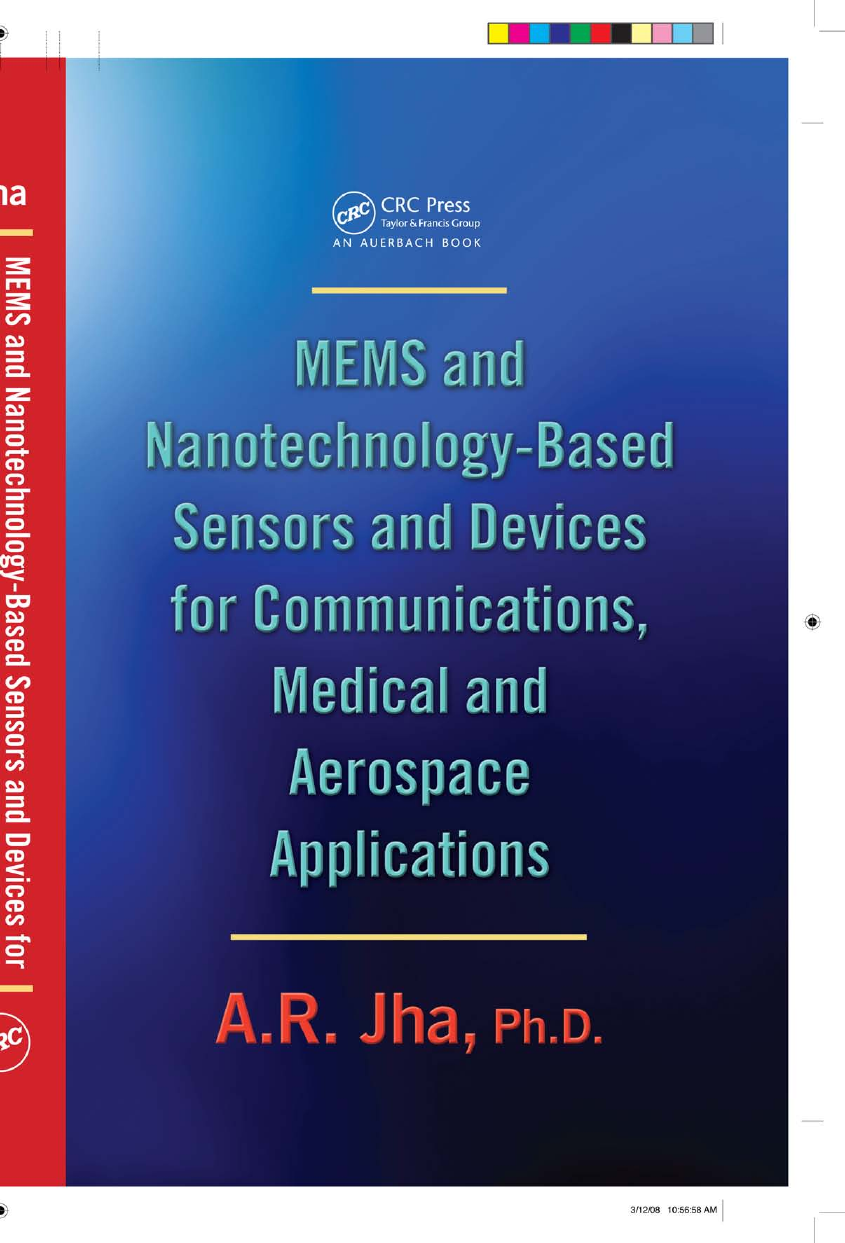
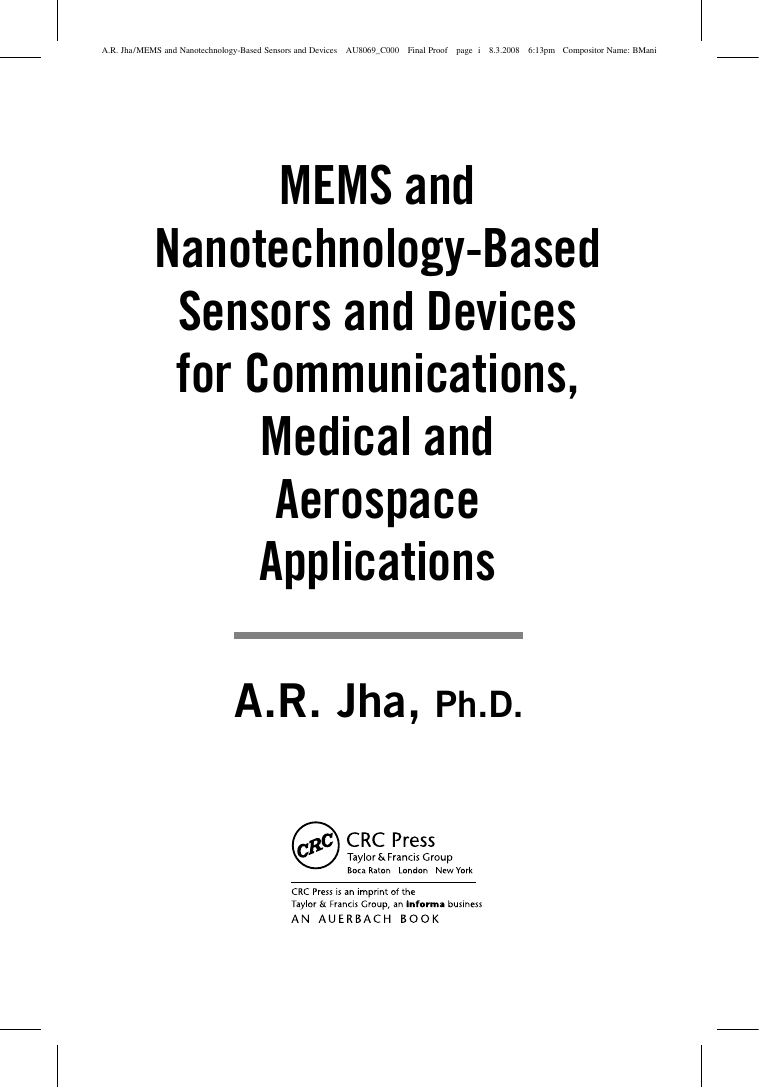



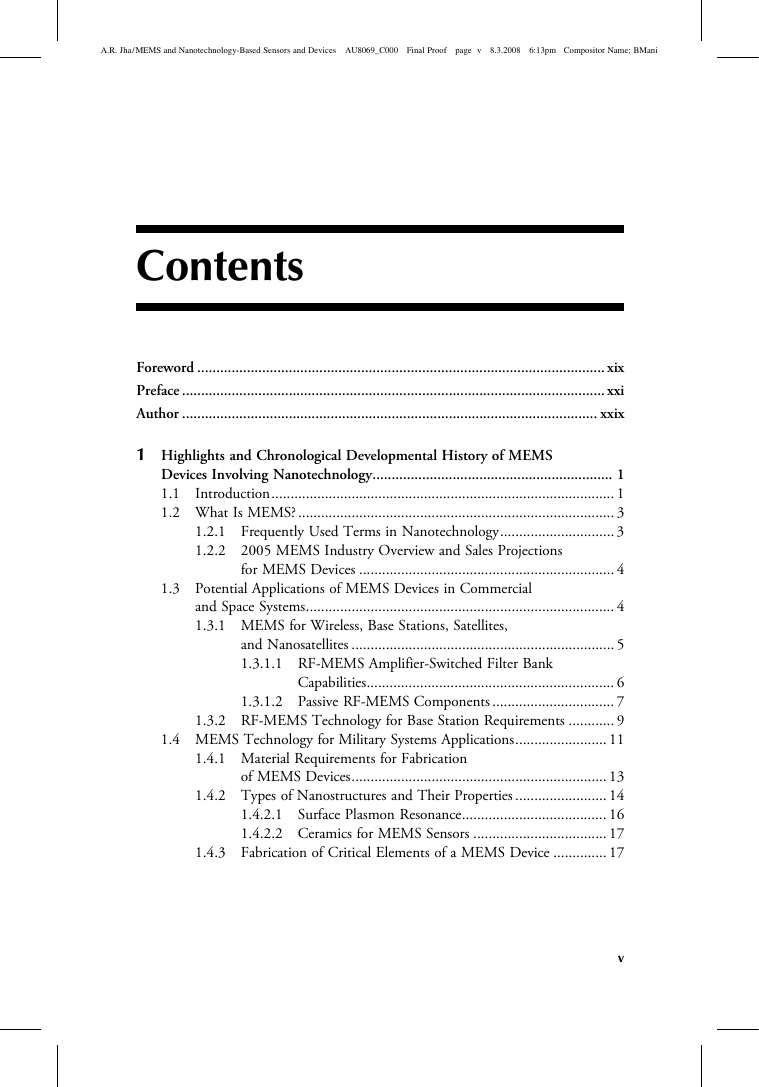
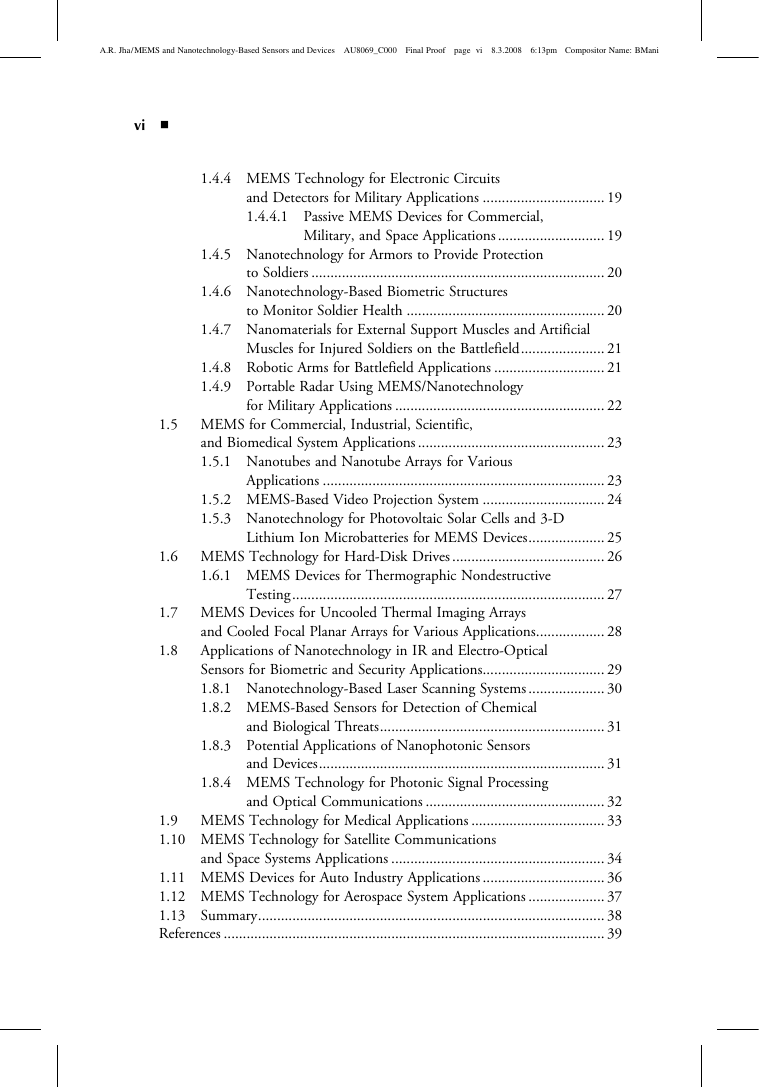
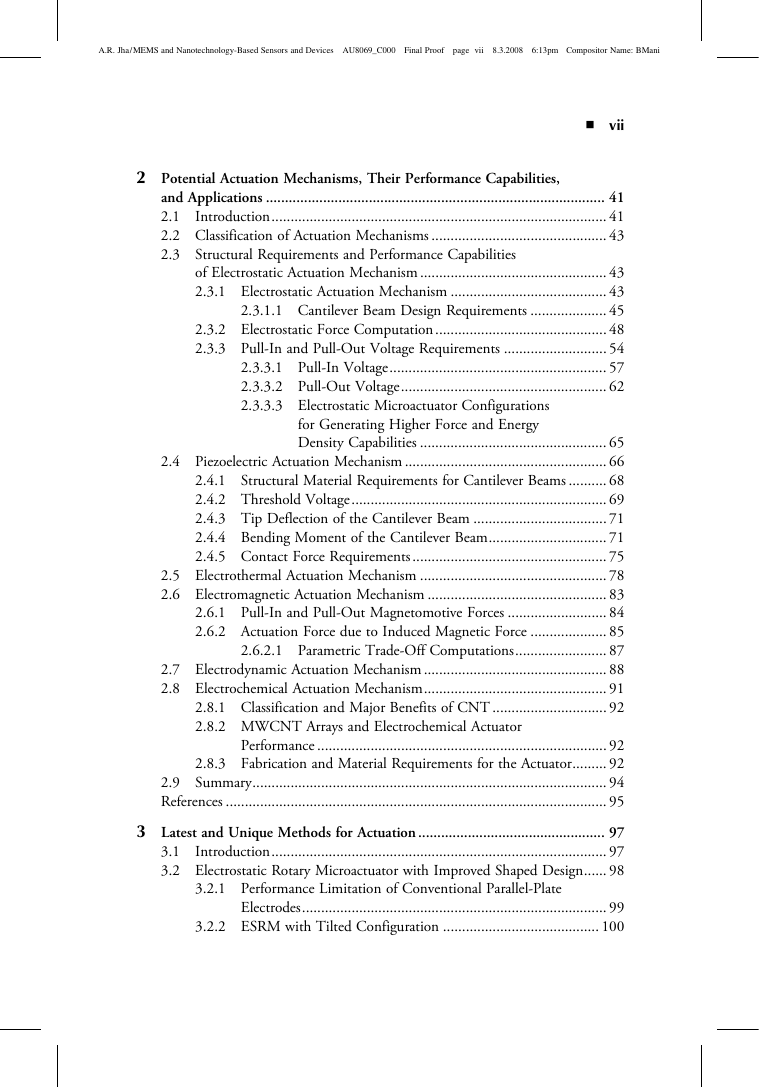








 2023年江西萍乡中考道德与法治真题及答案.doc
2023年江西萍乡中考道德与法治真题及答案.doc 2012年重庆南川中考生物真题及答案.doc
2012年重庆南川中考生物真题及答案.doc 2013年江西师范大学地理学综合及文艺理论基础考研真题.doc
2013年江西师范大学地理学综合及文艺理论基础考研真题.doc 2020年四川甘孜小升初语文真题及答案I卷.doc
2020年四川甘孜小升初语文真题及答案I卷.doc 2020年注册岩土工程师专业基础考试真题及答案.doc
2020年注册岩土工程师专业基础考试真题及答案.doc 2023-2024学年福建省厦门市九年级上学期数学月考试题及答案.doc
2023-2024学年福建省厦门市九年级上学期数学月考试题及答案.doc 2021-2022学年辽宁省沈阳市大东区九年级上学期语文期末试题及答案.doc
2021-2022学年辽宁省沈阳市大东区九年级上学期语文期末试题及答案.doc 2022-2023学年北京东城区初三第一学期物理期末试卷及答案.doc
2022-2023学年北京东城区初三第一学期物理期末试卷及答案.doc 2018上半年江西教师资格初中地理学科知识与教学能力真题及答案.doc
2018上半年江西教师资格初中地理学科知识与教学能力真题及答案.doc 2012年河北国家公务员申论考试真题及答案-省级.doc
2012年河北国家公务员申论考试真题及答案-省级.doc 2020-2021学年江苏省扬州市江都区邵樊片九年级上学期数学第一次质量检测试题及答案.doc
2020-2021学年江苏省扬州市江都区邵樊片九年级上学期数学第一次质量检测试题及答案.doc 2022下半年黑龙江教师资格证中学综合素质真题及答案.doc
2022下半年黑龙江教师资格证中学综合素质真题及答案.doc